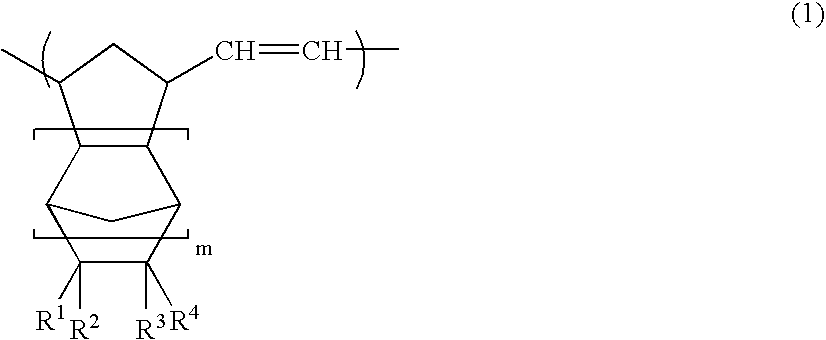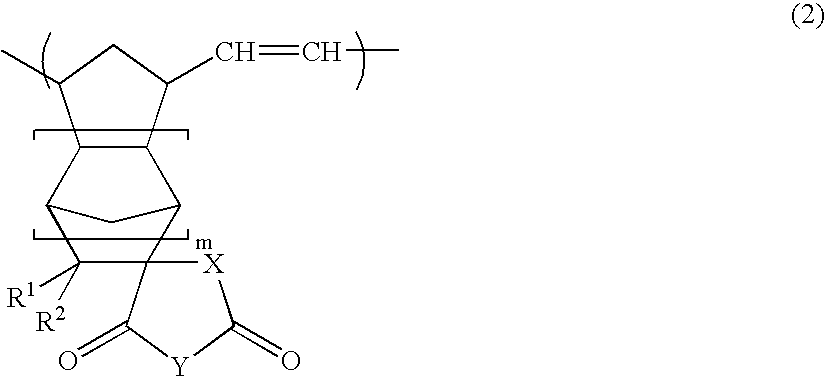Norbornene-based ring-opening polymerization polymer, product of hydrogenation of norbornene-based ring-opening polymerization polymer, and processes for producing these
a polymerization polymer and norbornene technology, applied in the field of new products, can solve the problems of large amount of polymerization catalyst, and large amount of functional group-containing norbornene monomer
- Summary
- Abstract
- Description
- Claims
- Application Information
AI Technical Summary
Benefits of technology
Problems solved by technology
Method used
Image
Examples
synthetic example 1
Preparation of Cyclopentadiene / Itaconic Anhydride Addition Product
[0143]A glass reaction vessel equipped with a stirrer was charged with a solution of 50 parts of itaconic anhydride in 90 parts of tetrahydrofuran. While gradually adding 35 parts of cyclopentadiene, the mixture was stirred at 0° C. for three hours. The solvent was removed under reduced pressure to obtain a residue. 90 parts of toluene was added to the residue, and the mixture was sufficiently stirred. The precipitated solid component was removed by filtration to obtain a filtrate. 70 parts of n-hexane was added to the filtrate, and the mixture was allowed to stand overnight at −30° C. The precipitate was washed with n-hexane and dried to obtain white crystals. 1H-NMR measurement confirmed that these crystals were a cyclopentadiene / itaconic anhydride addition product (a compound of the formula (6), wherein R1 and R2 are hydrogen atoms, Y is an oxygen atom, X is a methylene group, and m is 0).
synthetic example 2
Preparation of Cyclopentadiene / Itaconimide Addition Product
[0144]Crystals were obtained in the same manner as in Preparation Example 1, except for using itaconimide instead of itaconic anhydride. 1H-NMR measurement confirmed that these crystals were a cyclopentadiene / itaconimide addition product (a compound of the formula (6), wherein R1 and R2 are hydrogen atoms, Y is NH, X is a methylene group, and m is 0).
synthetic example 3
Preparation of Cyclopentadiene / Maleic Anhydride Addition Product
[0145]Crystals were obtained in the same manner as in Preparation Example 1, except for using 45 parts of maleic anhydride instead of 50 parts of itaconic anhydride. 1H-NMR measurement confirmed that these crystals were a cyclopentadiene / maleic anhydride addition product (bicyclo[2.2.1]hept-5-ene-2,3-dicarboxylic anhydride).
PUM
| Property | Measurement | Unit |
|---|---|---|
| mol % | aaaaa | aaaaa |
| water absorption | aaaaa | aaaaa |
| water absorption | aaaaa | aaaaa |
Abstract
Description
Claims
Application Information
 Login to View More
Login to View More - R&D
- Intellectual Property
- Life Sciences
- Materials
- Tech Scout
- Unparalleled Data Quality
- Higher Quality Content
- 60% Fewer Hallucinations
Browse by: Latest US Patents, China's latest patents, Technical Efficacy Thesaurus, Application Domain, Technology Topic, Popular Technical Reports.
© 2025 PatSnap. All rights reserved.Legal|Privacy policy|Modern Slavery Act Transparency Statement|Sitemap|About US| Contact US: help@patsnap.com



